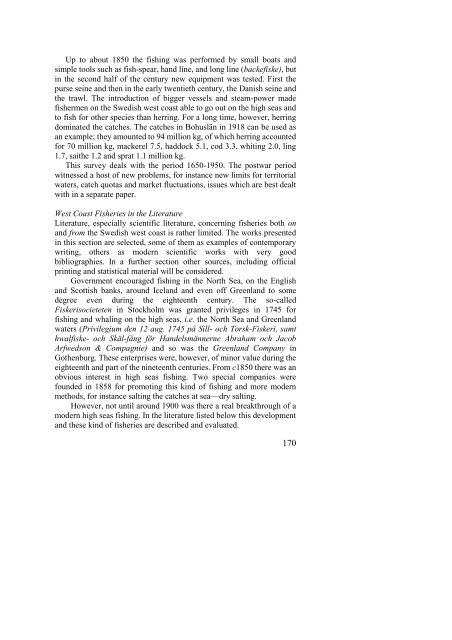The North Atlantic Fisheries, 1100-1976 - University of Hull
The North Atlantic Fisheries, 1100-1976 - University of Hull
The North Atlantic Fisheries, 1100-1976 - University of Hull
You also want an ePaper? Increase the reach of your titles
YUMPU automatically turns print PDFs into web optimized ePapers that Google loves.
Up to about 1850 the fishing was performed by small boats and<br />
simple tools such as fish-spear, hand line, and long line (backefiske), but<br />
in the second half <strong>of</strong> the century new equipment was tested. First the<br />
purse seine and then in the early twentieth century, the Danish seine and<br />
the trawl. <strong>The</strong> introduction <strong>of</strong> bigger vessels and steam-power made<br />
fishermen on the Swedish west coast able to go out on the high seas and<br />
to fish for other species than herring. For a long time, however, herring<br />
dominated the catches. <strong>The</strong> catches in Bohuslän in 1918 can be used as<br />
an example; they amounted to 94 million kg, <strong>of</strong> which herring accounted<br />
for 70 million kg, mackerel 7.5, haddock 5.1, cod 3.3, whiting 2.0, ling<br />
1.7, saithe 1.2 and sprat 1.1 million kg.<br />
This survey deals with the period 1650-1950. <strong>The</strong> postwar period<br />
witnessed a host <strong>of</strong> new problems, for instance new limits for territorial<br />
waters, catch quotas and market fluctuations, issues which are best dealt<br />
with in a separate paper.<br />
West Coast <strong>Fisheries</strong> in the Literature<br />
Literature, especially scientific literature, concerning fisheries both on<br />
and from the Swedish west coast is rather limited. <strong>The</strong> works presented<br />
in this section are selected, some <strong>of</strong> them as examples <strong>of</strong> contemporary<br />
writing, others as modern scientific works with very good<br />
bibliographies. In a further section other sources, including <strong>of</strong>ficial<br />
printing and statistical material will be considered.<br />
Government encouraged fishing in the <strong>North</strong> Sea, on the English<br />
and Scottish banks, around Iceland and even <strong>of</strong>f Greenland to some<br />
degree even during the eighteenth century. <strong>The</strong> so-called<br />
Fiskerisocieteten in Stockholm was granted privileges in 1745 for<br />
fishing and whaling on the high seas, i.e. the <strong>North</strong> Sea and Greenland<br />
waters (Privilegium den 12 aug. 1745 på Sill- och Torsk-Fiskeri, samt<br />
hwalfiske- och Skäl-fång för Handelsmännerne Abraham och Jacob<br />
Arfwedson & Compagnie) and so was the Greenland Company in<br />
Gothenburg. <strong>The</strong>se enterprises were, however, <strong>of</strong> minor value during the<br />
eighteenth and part <strong>of</strong> the nineteenth centuries. From c1850 there was an<br />
obvious interest in high seas fishing. Two special companies were<br />
founded in 1858 for promoting this kind <strong>of</strong> fishing and more modern<br />
methods, for instance salting the catches at sea—dry salting.<br />
However, not until around 1900 was there a real breakthrough <strong>of</strong> a<br />
modern high seas fishing. In the literature listed below this development<br />
and these kind <strong>of</strong> fisheries are described and evaluated.<br />
170















